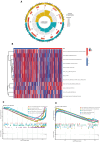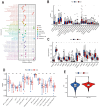Angiogenesis-related lncRNAs index: A predictor for CESC prognosis, immunotherapy efficacy, and chemosensitivity
- PMID: 38706901
- PMCID: PMC11064265
- DOI: 10.7150/jca.94332
Angiogenesis-related lncRNAs index: A predictor for CESC prognosis, immunotherapy efficacy, and chemosensitivity
Abstract
Cervical squamous cell carcinoma and endocervical adenocarcinoma (CESC) is a common gynecologic tumor and patients with advanced and recurrent disease usually have a poor clinical outcome. Angiogenesis is involved in the biological processes of tumors and can promote tumor growth and invasion. In this paper, we created a signature for predicting prognosis based on angiogenesis-related lncRNAs (ARLs). This provides a prospective direction for enhancing the efficacy of immunotherapy in CESC patients. We screened seven OS-related ARLs by univariate and multivariate regression analyses and Lasso analysis and developed a prognostic signature at the same time. Then, we performed an internal validation in the TCGA-CESC cohort to increase the precision of the study. In addition, we performed a series of analyses based on ARLs, including immune cell infiltration, immune function, immune checkpoint, tumor mutation load, and drug sensitivity analysis. Our created signature based on ARLs can effectively predict the prognosis of CESC patients. To strengthen the prediction accuracy of the signature, we built a nomogram by combining signature and clinical features.
Keywords: Angiogenesis; CESC; Chemotherapy; Immunotherapy; LncRNAs; Prognostic signature.
© The author(s).
Conflict of interest statement
Competing Interests: The authors have declared that no competing interest exists.
Figures











References
LinkOut - more resources
Full Text Sources

